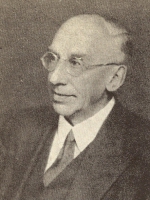George W.C. Kaye

Affiliation
Country
United Kingdom
George W.C. Kaye (1880 – 1941) was born on April 8, 1880 in Honley, West Riding of Yorkshire. He attended the University College in Liverpool and the Royal College of Science, where he obtained a degree in experimental physics with first-class honour. Following this, he went to Trinity College in Cambridge, first as a research student and later as a sub-lector.
Kaye entered the Huddersfield Technical College in 1893 having obtained a West Riding County Council Scholarship. When he was at the technical college, Rontgen’s discovery became known and the science teacher was soon engaged in setting up an X-ray tube in which activity Kaye assisted. The subject of X-rays became a life interest to him. In 1897 Kaye was awarded a Lancashire County Council Scholarship, and in 1899 he received a National Scholarship of the Science and Art Department. In that year he studied physics for a short time at Liverpool University under Sir Oliver Lodge, from there he migrated to the Royal College of Science, where he attended lectures by Callendar (who was appointed in 1901) and by John Perry. After taking his degree with first-class honours in physics, he remained as a demonstrator and was appointed a teaching associate in 1904. He was editor of the Royal College of Science Magazine from 1902 to 1905.
During his career, Kaye worked at the Cavendish Laboratory and at the Metrology Department of the National Physical Laboratory. His most popular work is called “Tables of Physical and Chemical Constants and Some Mathematical Functions” (Kaye and Laby 1911). Later he became interested in radiation physics and in 1914 he published a book entitled “X-rays” (Kaye 1914). At the Physics Department he begun to work with radium, and was in charge of radium testing. After the first world war, he continued working in this field and became a member of the National Radium Commission which controlled the care and distribution of radium. At that time, the health impacts of ionising radiation were unclear and scientific guidance for radiological protection was needed.
Kaye was a driving force in the formation and the early years of the International X-ray and Radium Protection Committee (IXRPC), which was created at the 2nd International Congress of Radiology in 1928 and is now known as ICRP. He was one of the first seven members of IXRPC and was Honorary Secretary in the years 1928, 1931 and 1934. In 1937, he was the Chairman at the annual IXRPC meeting. By the work and engagement of George W.C. Kaye, a fundamental contribution was made for the development of the system of radiological protection that we know today.
REFERENCES:
https://www.npl.co.uk/famous-faces/george-clarkson-kaye
Kaye, G., Laby, T. 1911. Tables of physical and chemical constants and some mathematical functions. Longmans, Green and Co.
Kaye, G. 1914. X Rays: An introduction to the study of rontgen rays. Longmas, Green and Co.